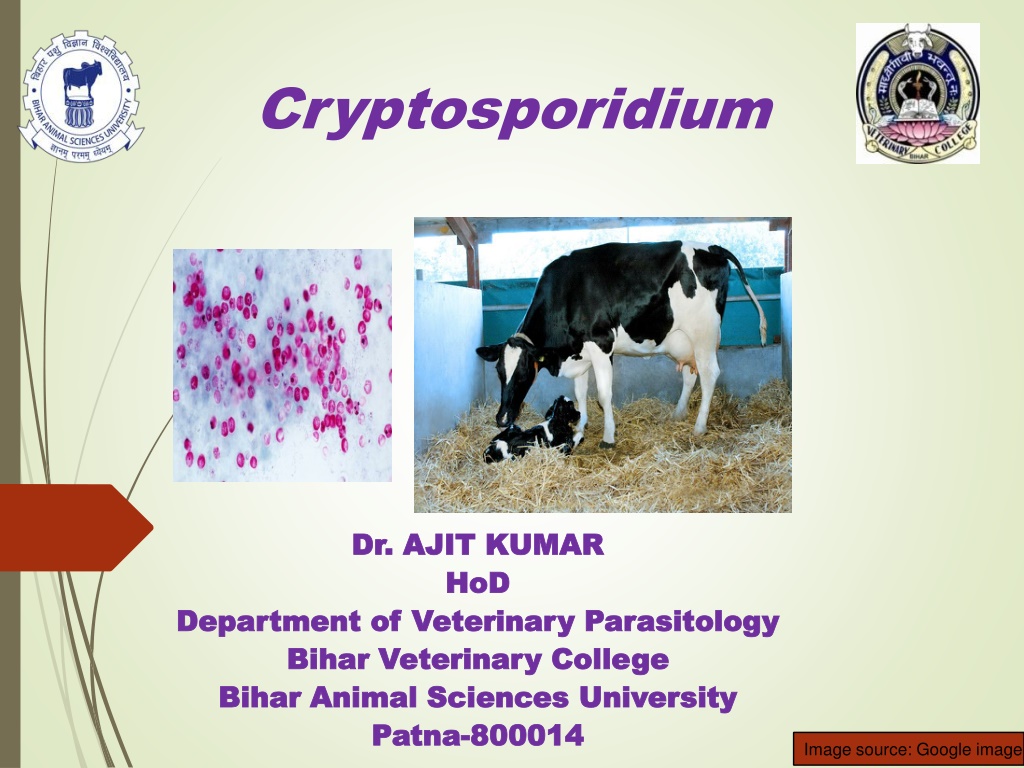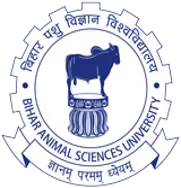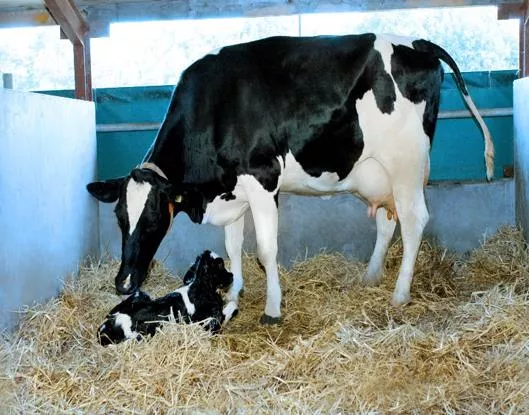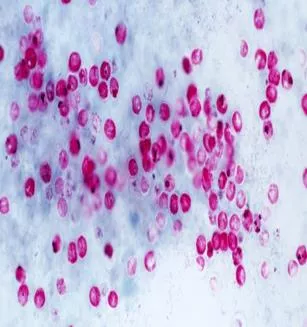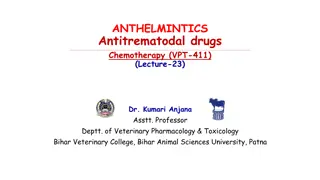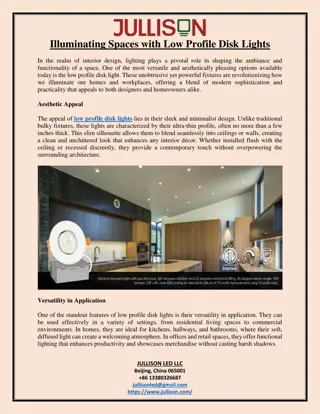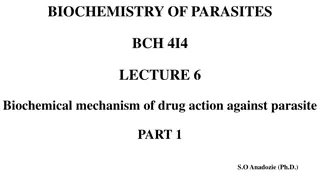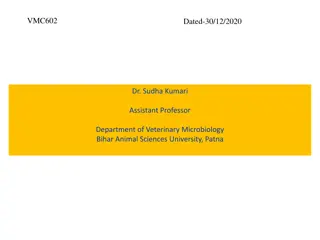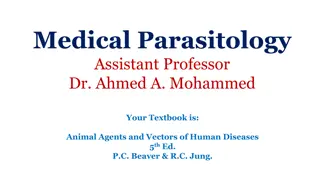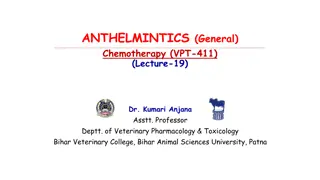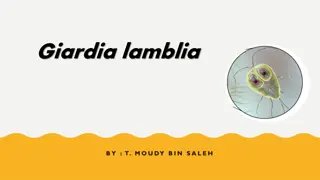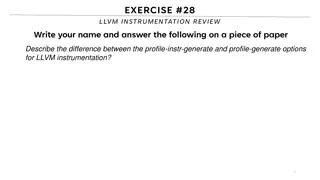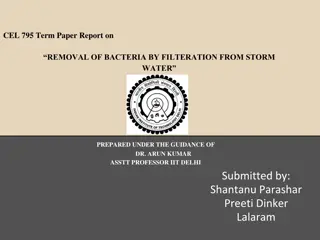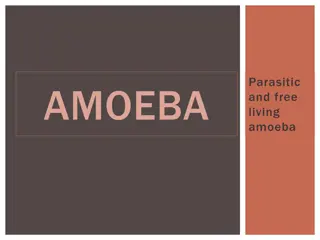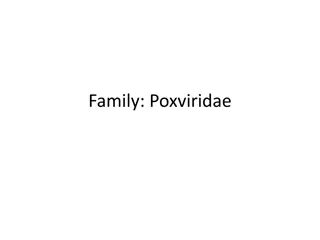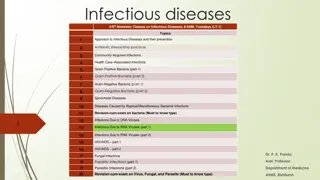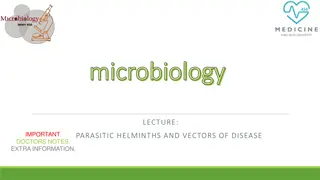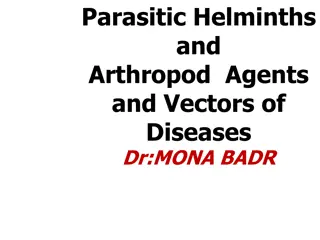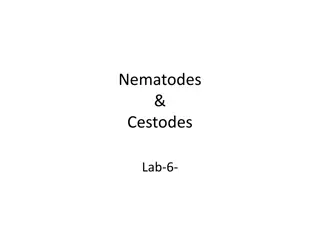Cryptosporidium: A Profile of the Parasitic Genus
The genus Cryptosporidium comprises intracellular organisms found in the gut and respiratory epithelium of various hosts, including humans and animals. These parasites have a unique life cycle involving thick-walled oocysts and can be transmitted through contaminated water or inhalation. Different species of Cryptosporidium infect a range of animals, showcasing their diverse host specificity.
Download Presentation

Please find below an Image/Link to download the presentation.
The content on the website is provided AS IS for your information and personal use only. It may not be sold, licensed, or shared on other websites without obtaining consent from the author.If you encounter any issues during the download, it is possible that the publisher has removed the file from their server.
You are allowed to download the files provided on this website for personal or commercial use, subject to the condition that they are used lawfully. All files are the property of their respective owners.
The content on the website is provided AS IS for your information and personal use only. It may not be sold, licensed, or shared on other websites without obtaining consent from the author.
E N D
Presentation Transcript
Bihar Animal Sciences University | Cryptosporidium Dr. AJIT KUMAR Dr. AJIT KUMAR HoD HoD Department of Veterinary Parasitology Department of Veterinary Parasitology Bihar Veterinary College Bihar Veterinary College Bihar Animal Sciences University Bihar Animal Sciences University Patna Patna- -800014 800014 Image source: Google image
Genus: Cryptosporidium o It cytoplasmic organism located in the notch of microvillus membrane of epithelium of gut wall and enclosing the parasite within a parasitophorus apparently microvilli. is an intracellular extra the digestive envelope from derived
Genus: Cryptosporidium o It also found in respiratory epithelium. o It It is parasite parasite found birds birds and and man is a a emerging emerging coccidian found in man. . coccidian in animals, animals, o Monoxenous Monoxenous parasite direct direct life life- -cycle parasite cycle. . with with
Genus: Cryptosporidium o It It has - -5 5. .6 6 m has smallest smallest oocyst m ) ) among among all oocyst ( ( 5 5- -7 7. .4 4 m all coccidian coccidian. . m X X 4 4. .5 5 o Ocysts Ocysts are and and ocyst and and colourless colourless. . are spherical spherical to ocyst wall wall is is bilayered to ovoid ovoid in in shape bilayered, , smooth shape smooth o Sporogony Sporogony occurs occurs inside inside the the host host. .
Genus: Cryptosporidium o Sporulated Sporulated oocysts excreted excreted though faeces faeces infected infected host host . . oocysts though the of of the the the oEach Each sporulated sporulated oocyst contains contains sporozoites sporocyst. oocyst four naked without Image source: Google image
Cryptosporidium species Species Species Host Host Cryptosporidium parvum Ruminants C. hominis man and monkey C. bovis cattle C. canis Dog C. suis Pig C. baileyi Birds
Genus: Cryptosporidium Life Life- - cycle cycle : : Direct Direct Infective Infective stage sporulated sporulated oocysts Transmission Transmission: : o Host Host gets gets infection ingestion ingestion oocysts oocysts contaminated contaminated water water or or through inhalation (aerosol). stage : : thick oocysts. . thick walled walled infection through of of sporulated sporulated through through through feed feed and and
Genus: Cryptosporidium Transmission: o Auto-infection occurs in Cryptosporidium because thin walled oocysts do not leave the host s intestine and initiate developmental cycle. a new
Genus: Cryptosporidium o Unlike the members of the eimeriidae, it does not enter the cells of the host and specificity so that cross infection occurs between domestic and laboratory animals and birds. lacks host
Genus: Cryptosporidium o Two types of oocysts are formed i.e. thin thin walled thick thick walled walled oocysts oocysts. o Thick walled oocysts pass out in the infected hosts thin walled oocysts excyst in the gut and released sporozoites infection. walled and and faeces whereas of cause auto-
Life- cycle of Cryptosporidium Image source: Google image
Pathogenesis of Cryptosporidium Generally Generally calves, calves, kid, are are most most affected young young lam, children children etc affected. . hosts hosts like like etc. . kid, lam, It It degeneration, degeneration, enterocytes, enterocytes, crypt inflammation inflammation of etc etc. . causes causes villus villus sloughing sloughing crypt hypertrophy, hypertrophy, of epithelial epithelial cells atrophy, atrophy, of of cells
Cryptosporidium Symptoms Symptoms: : o Depend Depend upon upon species parasites parasites and and and immunity immunity status the the host host. . species of and the the age status of of age of o Watery Watery diarrhoea diarrhoea is the cardinal sign. cholera cholera like like
symptoms of Cryptosporidium Symptoms: o Other weight loss, abdominal discomfort, dehydration etc. o Cryptosporidia is also regarded as potential cause of diarrhoea. symptoms are traveler s
Genus: Cryptosporidium Diagnosis Diagnosis : : On On the like like diarrhoea diarrhoea in the basis basis of Watery Watery in young of symptoms symptoms cholera cholera young hosts hosts. . o like like Diagnosis observing sporulated oocysts in Ziehl Neelsen Neelsen stained stained (Acid Staining Staining or or Kinyoun fast fast stain) faecal smears. is made by o very small Ziehl- - Fast acid (Acid Fast Kinyoun acid Image source: Google image
Genus: Cryptosporidium Treatment Treatment o Drug Drug like like Azithromycin, Azithromycin, Paromomycin Paromomycin etc etc. . are are used used used used in in treatment treatment. .
Genus: Cryptosporidium Control Control- - o Proper Proper faeces faeces/stool o Uncooked Uncooked vegetables salad salad should should be after after proper proper washing o Proper Proper washing washing of before before meal meal. . disposal disposal of of /stool. . vegetables like be taken washing. . of hands like taken hands
